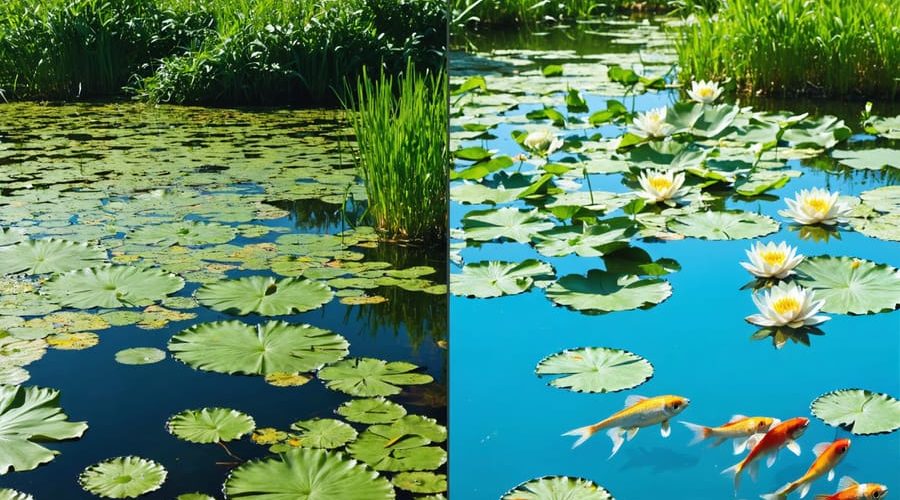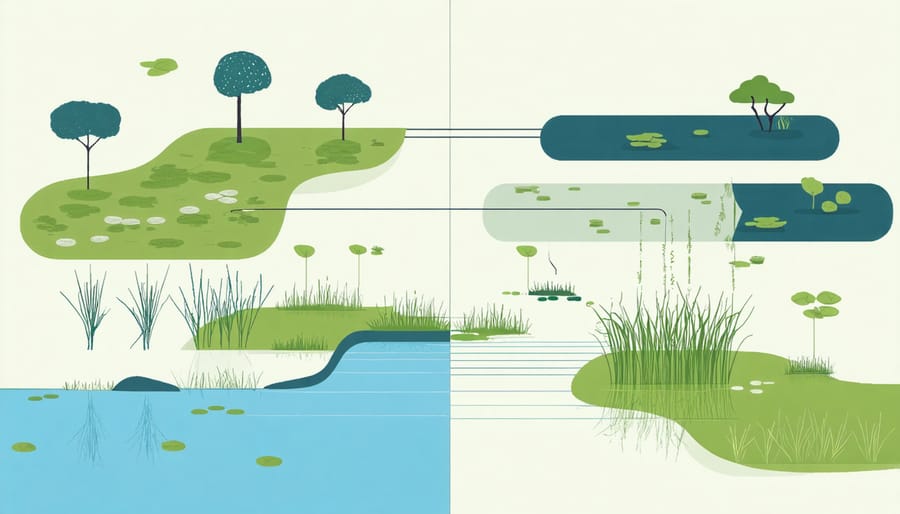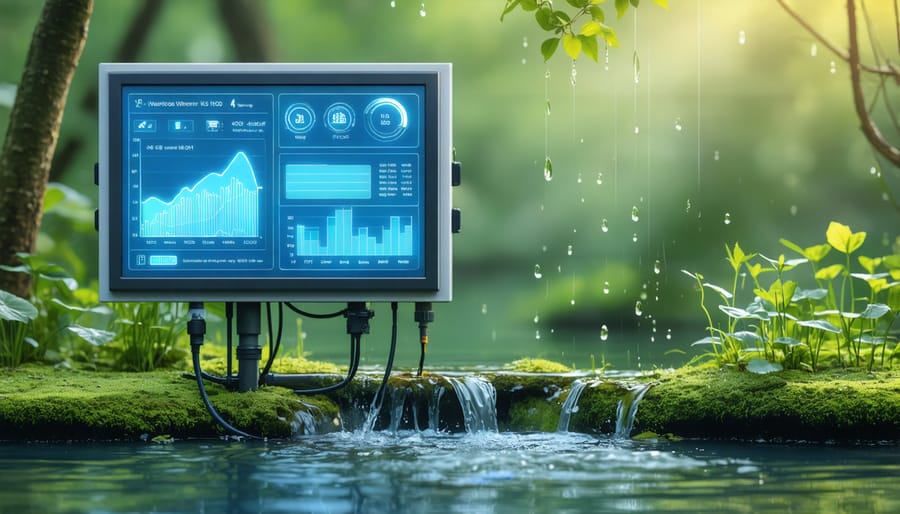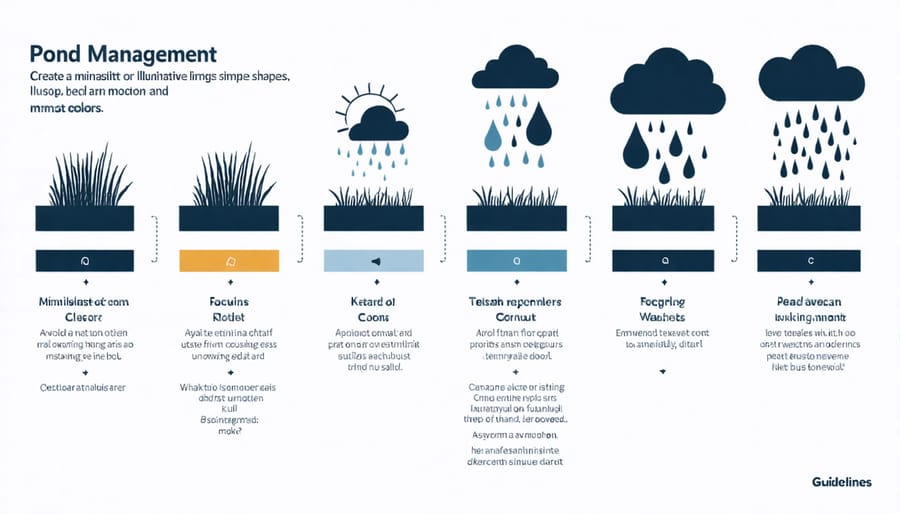
Smart Water Management: How to Keep Your Pond Thriving in Unpredictable Weather
Adapt pond management strategies weekly based on water quality readings, fish behavior, and changing climate conditions. Monitor oxygen levels, temperature fluctuations, and algae growth patterns to make informed, real-time adjustments that protect your aquatic ecosystem. Establish flexible maintenance schedules that respond to seasonal transitions, unexpected weather events, and shifting environmental factors rather than following rigid routines.
This dynamic approach transforms traditional pond care into a responsive system that anticipates and addresses challenges before they become problems. By treating your pond as a living, breathing ecosystem that requires ongoing observation and adjustment, you’ll develop a deeper understanding of its unique rhythms and needs. Think of adaptive management as having a conversation with your pond – listening to its signals and responding with appropriate actions that maintain balance and beauty throughout the year.
Smart pond owners know that success lies not in following a fixed blueprint but in building an intuitive relationship with their water feature. This flexible mindset helps navigate everything from sudden temperature swings to unexpected algae blooms while maintaining optimal conditions for fish and plants.
Understanding Adaptive Water Management
Key Principles of Adaptive Management
Adaptive management in water features revolves around three essential principles: observation, flexibility, and proactive response. Think of your pond as a living ecosystem that constantly changes with the seasons and weather patterns. Regular monitoring helps you spot potential issues before they become problems, whether it’s changes in water clarity, plant growth, or fish behavior.
Being flexible with your maintenance schedule is crucial. While having a routine is important, you’ll need to adjust based on what your pond needs at any given time. For example, you might need more frequent water testing during hot summers or extra debris removal during fall.
The most successful pond owners develop a feedback loop – they observe changes, take action, and then evaluate the results. This cycle helps you learn what works best for your specific water feature. Keep a simple log of your observations and actions, which will help you make better decisions over time.
Remember that prevention is often easier than cure. By staying alert to small changes and responding quickly, you’ll maintain a healthier, more stable environment for your aquatic plants and fish.

Why Traditional Methods Fall Short
Traditional pond management often relies on fixed schedules and one-size-fits-all solutions, but these methods rarely account for the dynamic nature of water ecosystems. Take regular water testing, for instance – doing it on a set monthly schedule might miss sudden changes that need immediate attention. When algae blooms appear unexpectedly or fish show signs of stress, waiting for the next scheduled maintenance could lead to serious problems.
Fixed feeding schedules and predetermined chemical treatments don’t consider varying weather conditions, seasonal changes, or the unique characteristics of your pond. What works perfectly in spring might be completely ineffective during a hot summer or unusually wet season. Many pond owners have learned the hard way that following rigid maintenance routines can actually do more harm than good.
Moreover, traditional approaches often treat symptoms rather than addressing root causes. Adding chemicals to combat algae without understanding why it’s growing in the first place is like putting a bandaid on a deeper problem. These reactive methods not only cost more in the long run but can create a cycle of dependency on treatments that might not be necessary with a more flexible approach.
Monitoring and Response Systems
Critical Water Parameters to Track
Keeping your pond healthy means staying on top of a few key water parameters. Think of these as your pond’s vital signs – they’ll tell you when things are going well and when you need to make adjustments. Let’s look at the most important ones to track:
pH levels should stay between 6.5 and 8.5 for most pond life to thrive. Test this weekly, as sudden changes can stress your fish and plants. Dissolved oxygen is another crucial factor – aim for at least 6-8 mg/L to keep your aquatic friends happy and healthy.
Temperature is a game-changer in pond management. Most pond fish do best between 50-75°F (10-24°C). Keep a thermometer in your pond and check it regularly, especially during seasonal changes. Ammonia and nitrite levels should always be at zero – anything higher can harm your fish. Test these parameters weekly or whenever you notice unusual fish behavior.
Don’t forget about phosphate levels, which can trigger algae blooms if they get too high. Keep them below 0.5 mg/L. Clarity is also important – use a Secchi disk or simply monitor how deep you can see into your pond. If visibility decreases, it might indicate an developing issue that needs attention.
Regular testing doesn’t have to be complicated – a basic water testing kit will cover most of these parameters. Keep a log of your readings to spot trends and make informed decisions about your pond’s care.

Creating Your Response Plan
Creating a solid response plan starts with identifying potential challenges your pond might face throughout the year. Begin by maintaining a simple log of weather patterns, water quality readings, and any issues you’ve encountered. This documented history becomes your guide for developing targeted solutions.
Next, establish trigger points – specific conditions that signal when action is needed. For example, set temperature thresholds that prompt additional aeration or water level markers that indicate when to implement water-efficient pond management strategies.
Break down your response plan into three categories:
1. Immediate actions (within 24 hours)
2. Short-term solutions (2-7 days)
3. Long-term adjustments (seasonal changes)
For each category, list specific steps you’ll take. For instance, an immediate action might be adding shade cloth during a heatwave, while a long-term adjustment could involve installing additional plants for natural filtration.
Keep your response tools readily accessible. Create a dedicated storage area for emergency supplies like water treatments, backup pump parts, and testing kits. Label everything clearly and check expiration dates regularly.
Remember to review and update your plan quarterly, incorporating lessons learned from each challenge you face. This ongoing refinement is what makes adaptive management truly effective for your pond’s health.

Practical Adaptive Strategies
Drought Management Solutions
During dry periods, maintaining a healthy pond requires a proactive approach and careful attention to water management. Start by implementing regular seasonal pond maintenance to prepare for potential drought conditions.
One of the most effective strategies is installing a reliable water level monitor. This simple device alerts you when water levels drop below critical points, helping you respond quickly to prevent stress on your pond’s ecosystem. Consider adding a pond cover or floating plants to reduce water loss through evaporation – water lilies and lotus are beautiful options that serve this practical purpose while enhancing your pond’s appearance.
Deep zones in your pond act as refuges for fish during dry spells. If you’re designing a new pond or renovating an existing one, include areas at least 3-4 feet deep. These deeper sections maintain cooler temperatures and provide stable conditions when water levels decrease.
Smart aeration is crucial during drought periods. While you might think running aerators less would conserve water, maintaining good oxygen levels actually helps your pond stay healthier with less water. Consider using a variable-speed pump that can adjust to different water levels while maintaining efficient circulation.
For emergency situations, keep a backup water supply ready. This could be stored rainwater from collection systems or a dedicated reservoir. Remember that adding new water suddenly can shock pond life, so introduce it gradually and ensure it’s properly conditioned.
During extended dry periods, reduce fish feeding slightly, as warmer water with less volume means less dissolved oxygen for your finned friends. This simple adjustment helps maintain water quality when resources are limited.
Heavy Rain Preparation
Heavy rain can quickly turn your peaceful pond into a challenging situation, but with proper preparation, you can protect your water feature and its inhabitants. Start by installing an overflow system that directs excess water away from your pond. A simple overflow pipe or spillway can prevent flooding while maintaining optimal water levels.
Consider creating a rain garden near your pond to capture and filter runoff before it enters your water feature. Plant water-loving species like rushes and sedges that help absorb excess nutrients and prevent erosion. During heavy rainfall, these plants act as natural filters, improving water quality.
Keep your skimmer and filtration systems well-maintained to handle the increased water flow. Regular cleaning of filters and removal of debris becomes especially important before expected rainfall. Install a backup pump system that automatically kicks in if your main pump gets overwhelmed, ensuring continuous circulation even during storms.
Monitor your pond’s edges for potential erosion points and reinforce them with rocks or appropriate landscaping. Creating gentle slopes around your pond helps manage water flow and prevents soil from washing into your pond. Consider installing rain barrels or retention areas upstream from your pond to collect and slow down water flow during heavy downpours.
For koi and fish owners, having an emergency air pump ready is essential, as heavy rain can decrease oxygen levels. Keep testing kits handy to monitor water parameters, particularly after significant rainfall when runoff might affect water chemistry. Remember to check your pond’s depth markers regularly to ensure water levels stay within safe limits.
With these preparations in place, your pond will be better equipped to handle whatever mother nature sends your way, maintaining both its beauty and functionality through challenging weather conditions.
Temperature Control Techniques
Managing temperature fluctuations in your pond doesn’t have to be complicated. The key is implementing effective temperature control strategies that work with nature rather than against it. Start by monitoring your pond’s temperature regularly using a reliable thermometer – this gives you a baseline to work from and helps you spot concerning trends early.
For summer cooling, consider adding floating plants like water lilies, which provide natural shade and help maintain stable temperatures. Installing a pond umbrella or shade sail can offer additional protection during peak heat. Keeping your water moving with fountains or waterfalls not only adds beautiful ambiance but also helps regulate temperature through aeration.
During colder months, use a pond heater or de-icer to maintain a small ice-free area, ensuring proper gas exchange for your fish. Deep areas in your pond (at least 2-3 feet) act as natural temperature buffers, giving fish a comfortable retreat during extreme weather.
For year-round temperature management, consider these practical tips:
– Plant trees or tall plants on the west side of your pond for natural afternoon shade
– Maintain consistent water levels to help stabilize temperatures
– Use dark-colored bottom materials to absorb and retain heat
– Install a bottom drain to manage cold water layers
Remember, gradual temperature changes are always better than sudden ones, so implement these measures progressively as seasons change.
Embracing an adaptive management approach is truly a game-changer for pond owners. By staying flexible and responsive to your pond’s changing needs, you’ll create a more resilient and beautiful water feature that can weather any challenge. Remember, the key to success lies in regular monitoring, keeping detailed records, and being willing to adjust your strategies when needed.
Start small with basic observations and simple adjustments, then gradually build your confidence as you become more familiar with your pond’s patterns. Whether it’s tweaking your feeding schedule, adjusting plant coverage, or modifying your filtration system, each small change contributes to your pond’s overall health and beauty.
Don’t be afraid to experiment and learn from both successes and setbacks – they’re all valuable parts of the journey. Share experiences with fellow pond enthusiasts and stay connected with your local water gardening community. Their insights and support can be invaluable as you develop your adaptive management skills.
Most importantly, celebrate the progress you make along the way. Every healthy fish, blooming water lily, and crystal-clear day is a testament to your dedication and adaptive approach. With these strategies in hand, you’re well-equipped to create and maintain the pond of your dreams, no matter what challenges nature throws your way.
Get started today, and watch how your pond transforms into a thriving ecosystem that brings joy year after year.
